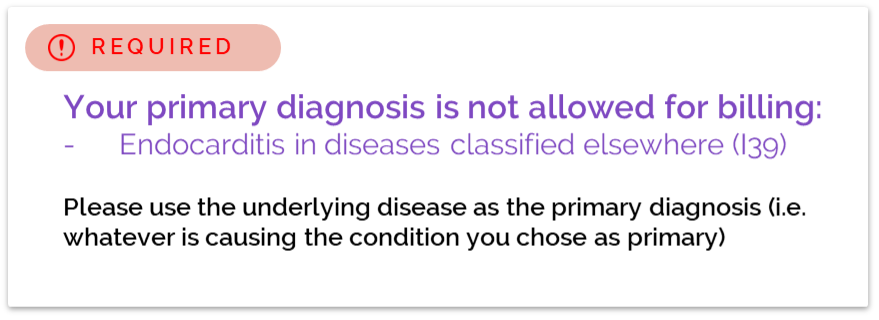What is the “code first” rule in medical billing and coding?
“Code first” is an ICD-10-CM sequencing coding guideline that instructs the medical coder to assign the underlying condition before coding the manifestation – that is, the secondary condition that results from the primary disease.
For example:
J91.8 Pleural effusion in other conditions classified elsewhere. J91.8 describes the manifestation of an underlying disease, not the disease itself.
“Code first” underlying disease, such as:
- Filariasis B74.0 – B74.9
- Influenza J09.X2, J10.1, J11.1
U09.9 Post COVID-19 condition, unspecified. Applicable to post-acute sequela of COVID-19.
“Code first” the specific condition related to COVID-19 if known, such as:
- Chronic respiratory failure J96.1
- Loss of smell R43.8
- Loss of taste R43.8
- multisystem inflammatory syndrome M35.81
- pulmonary embolism I26.-
- Pulmonary fibrosis J84.10
K31.84 Gastroparesis. Applicable to gastroparalysis.
“Code first” the underlying disease if known, such as:
- anorexia nervosa F50.0-
- diabetes mellitus E08.43, E09.43, E10.43, E11.43, E13.43
- Scleroderma M34.-
Why is “code first” often missed in medical coding?
Many clinicians are not trained in complex coding rules – they document diagnoses based on clinical relevance, not code sequencing. For the coder reviewing documentation downstream in their work queue it can result in:
- Unacceptable principal diagnosis (UPD)
- Significant time spent clarifying clinical details and correcting codes
- Claims rejected, resubmissions, or write-offs
Medical coders play a critical role in filling coding gaps by interpreting the clinical documentation correctly and applying sequencing rules appropriately.
How to avoid costly claim denials
Clinical terminology serves as the bridge between a clinician’s language and the standardized codes required for medical billing and reporting. IMO Health’s revenue cycle solution is built on consistently updated, proprietary content – that’s already within the EHR – and flags any problematic codes in real-time, prompting actionable corrections that are supported by clinical reasoning:

This approach leads to reclaimed coder time for higher-value work, reduced coder queries, enhanced provider coding education – and saved revenue.
What happens when you get medical coding right
After a short 90-minute implementation of IMO Health’s revenue cycle solution, one small, private multispecialty medical group saw a 54% reduction in denials from non-primary codes used in “code first” within the first month.





